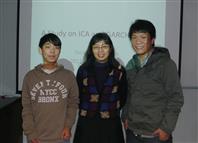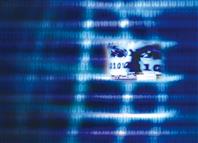British biologist and science writer Richard Dawkins is a famous atheist. Known as ‘Darwin’s Rottweiler’ for his advocacy of Charles Darwin’s evolutionary theory, he frowns on the idea that ‘computers only do exactly what you tell them to, and that therefore computers are never creative’. In his book The Blind Watchmaker published in 1986, Dawkins says, ‘The cliché is true only in the crashingly trivial sense, the same sense in which Shakespeare never wrote anything except what his first schoolteacher taught him to write—words.’
Prof. Chan Lai-wan at the Department of Computer Science and Engineering of CUHK is an expert on artificial neural network. She points out that although computers are still no match for the human brain in terms of creativity, the learning process of computers and that of the human brain are very similar.
Inspired by biological neural networks, an artificial neural network, or neural network as it is generally known, is a computational model for information processing. This subfield of artificial intelligence deals with the establishment of learning processes for computers. In other words, it is about teaching computers to learn. The objective of artificial intelligence is to enable computers to think and behave in the same way as a human being. So, creation of a learning process is the kernel. If computers are capable of learning, they will be able to solve problems by making deduction and judgments based on the knowledge they have acquired.
It is undeniable that computers’ learning is bounded by the materials that have been fed into them. Professor Chan explains, for example, when you teach a computer to identify the letter A, it would distinguish it from other letters fed into it by sorting out the distinctive features of the image of the letter A.
However, with the knowledge acquired, computers may sometimes give you unexpected answers. Two different networks may dish out different information even though they have acquired the same knowledge and have been fed the same information for processing. For example, a network may tell you that the number after 1, 2, 4 in an arithmetic progression is 8, while another one may tell you it is 7. Both answers are correct. It is because the way a computer thinks of an answer is determined by its learning process. When there is more than one answer, it will give you the one that it has first learned.
Just like their human counterparts, neural networks can be divided into fast learners and slow learners. The major cause is that different networks have different setups, which would affect the learning process, including its accuracy and learning speed when faced with different problems. ‘It’s like certain people are good at numbers, while some are good at literature. In computing terms, they’re the results of different setups.’ Besides, it may take 10 years, 20 years or more for a person to solve a very complex problem. This also holds true for computers. But if you break the problem down into smaller parts and tackle them one by one, it will be easier to solve. In the past, computers need human experts to break down problems for them. Recently, a computational model that can automatically break problems down has been created. ‘This is the new direction in the development of neural networks and is a breakthrough in artificial intelligence research.’
Professor Chan’s another research focus is data mining. She explains that the interest in data mining began in the early 1990s. With the advance of information technology, computers are now more powerful in storing and sifting through large amounts of data. Data mining refers to the technique of digging out hidden messages or useful intelligence from an enormous amount of data.
Data mining and neural networks are closely linked. The former is arguably the result of the latter. Neural networks would be very useful tools for data mining if they have learned to identify a particular feature from a large amount of data and recognize a particular pattern. Professor Chan focuses on data mining in financial applications, trying to locate the relationship between or the common factors of different shares or different types of shares. She uses algorithms to single out certain independent components from data. Each of these components is completely uncorrelated to others. And they are indicators of the rise and fall of share prices. It is useful for risk management. ‘In the past, it was believed that each component was technically uncorrelated to each other. But we found that it is better to extract and process independent components than to process uncorrelated components,’ said Professor Chan.
The Internet is so big and all encompassing today. Wherever you go on the Internet, you leave traces behind, such as your e-mail messages, online transaction records, web browsing history, social networking website information. All of them are mineable data that are useful for marketing, or product and service design.
Without our notice, we leave lasting digital footprints on the net. In that case, do we have any privacy at all? ‘Data mining does not target specific individuals, but a group of people. We’re trying to have a better understanding of people from their data,’ explains Professor Chan. ‘Data mining has a wide range of potential applications. For instance, now there is controversy over voter registration. By using the technique of data mining, we can find out under what circumstances or with what elements, foul play would be possible. This will enable us to take better precautions against it.’ 



































































































































































Social Bookmarks